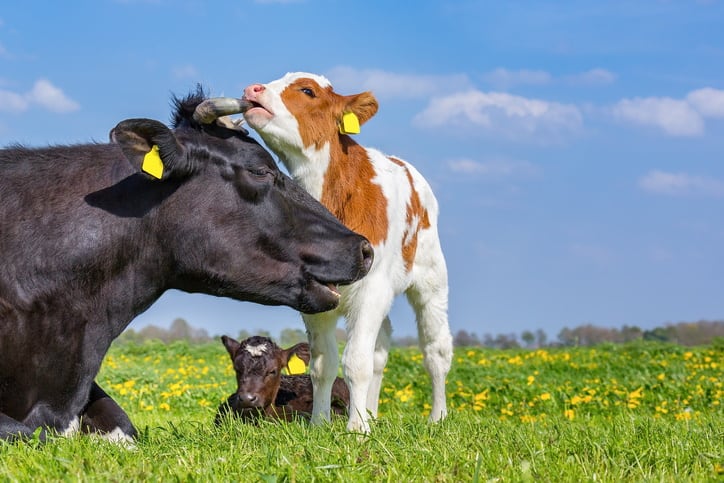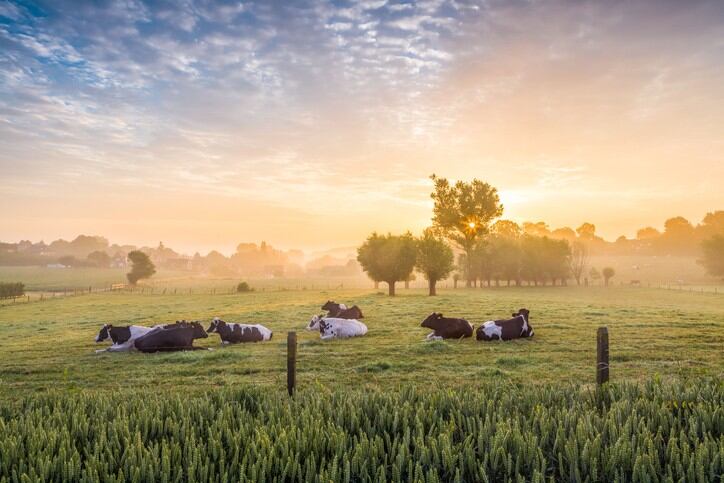In a landmark plan to achieve net-zero emissions by 2050, New Zealand has become the first country in the world to target a 24-47% reduction in biogenic methane by 2050.
The plan marks a milestone shift in governments addressing the footprint of the historically hard-to-decarbonise agriculture sector on the road to net zero. It will serve as a litmus test for how high-emitting sectors will respond to new regulation and the urgent need for transformation. In its new report Returns Gone Sour: The impact of carbon pricing on the dairy sector, the FAIRR initiative explores what the proposed scheme means for the future of dairy and its key stakeholders.
Dairy’s economic and environmental contribution
The dairy industry plays an important role in New Zealand’s economy; over 95% of milk produced is exported and in 2020 dairy exports contributed a total of NZ$10.2 billion to the economy. The sector is a top 10 purchaser of output from around a third of all other New Zealand industries, which collectively accounts for over 40% of GDP.
Though valuable to the economy, dairy production is costly to the environment. Over half of New Zealand’s total emissions come from agriculture, and a quarter from its dairy sector. Globally, the dairy industry makes up 3.4% of total emissions, a contribution close to that from aviation and shipping combined. It reflects the significant contribution of the food system: the Intergovernmental Panel on Climate Change (IPCC) estimated that 21-37% of total greenhouse gas (GHG) emissions are attributable to the food system, with around 14.5% linked to the livestock sector alone.
To account for these impacts, the FAIRR Initiative, a collaborative investor network, launched a $5 trillion global investor coalition including Legal & General Investment Management (UK) and Canada Post Corporation Pension Plan, alongside former UN Secretary-General Ban Ki-moon, calling for governments to disclose specific targets for reducing agricultural emissions as part of Nationally Determined Contributions (NDCs) in the lead up to COP26. In its 2020 NDC update, New Zealand confirmed its commitment to reducing biogenic methane emissions.
The repercussions of a carbon price for the dairy sector
New Zealand’s incoming carbon price brings a number of challenges for dairy producers. Our analysis finds that by 2050, carbon costs for New Zealand’s dairy sector could be equivalent to 26% of the current average operating profit of owner-operator dairy farms and 74% for sharemilking farms. For New Zealand’s largest dairy producer Fonterra, covered by the Coller FAIRR Protein Producer Index, carbon costs could be equivalent to 87% of 2020 EBITDA by 2050.
In the short term, reductions to stocking rates and production will be necessary to cut emissions. Without significant investments in methane-reducing technologies, achieving the lower end of the government’s target will require dairy cattle numbers to decrease by 15%. This risks instability in the supply chain due to a fall in the production of milk solids, while eating into farmers operating profits.
The projected carbon price for the sector is forecast to be between $48 and $90 per tonne by 2050. This cost, alongside those associated with carbon measurement and mitigation, will compound a pre-existing debt burden among dairy farmers. This comes in the wake of banks becoming increasingly hesitant to provide new lending for dairy farmland due to the costs of compliance with the regulation, and diversifying lending towards other low-impact agricultural sectors, most notably horticulture.
The plant-based threat
The increase in demand for plant-based alternatives will compound the regulatory risks associated with a carbon price. The global dairy alternatives market continues to increase in value and is projected to reach USD 40.6 billion by 2026, with the recent IPO of the plant based milk company Oatly, now valued at $13 billion USD, indicating the industry is on the up.
For the world’s largest exporter of dairy, New Zealand co-operative Fonterra, the demand for plant-based alternatives in its target markets is on the rise. New Zealand has the highest search volumes on ‘veganism’ globally, and as of 2019, plant-based alternatives account for 7% of milk consumed in Australia. China, which accounts for 25% of Fonterra’s exports, has been identified as a key target market for Oatly. Chinese dairy giant, Yili, has also been expanding its plant-based range since 2017.
Technological advancements in this space are also contributing towards an increasingly competitive market. Perfect Day, a producer of animal free milk protein, claim their product reduces GHG emissions by at least 85% compared to traditional dairy production methods. The company recently announced the opening of a new innovation centre in Singapore to meet the global demand for innovative, cost-effective and sustainable food solutions.
The low carbon opportunity
Around the world, dairy producers are exploring solutions to mitigate transition risks like carbon pricing. Some are investing in methane-reducing technologies including methane inhibitors, reduction vaccines and selective breeding for lower emitting animals. These alternatives, however, often come with higher costs for the dairy sector.
New Zealand’s carbon pricing plan for agriculture sets a policy precedent for addressing agricultural emissions at source and increasing regulation for dairy and livestock farmers alike. For instance, in April 2021, the Republic of Ireland introduced a draft agri-food strategy that includes a 10% reduction target in biogenic methane by 2030. This target is expected to reduce the current herd size in the region. As governments work towards achieving climate goals, setting targets specific to agricultural emissions and associated regulatory mechanisms will only become more widespread.
Policy action, combined with market and technological shifts, are creating a powerful disruptive force for the dairy sector. Investors will be watching closely to see how dairy producers respond to the decarbonisation challenge. Those that see incoming disruption as an opportunity to strengthen their position through portfolio diversification and sustainable farming practices will reap the benefits.
Explore FAIRR’s report, Returns Gone Sour: The impact of carbon pricing on the dairy sector, here.




